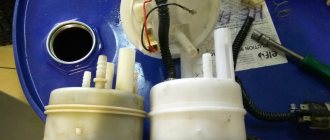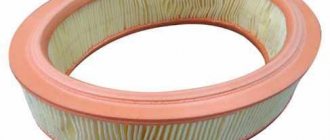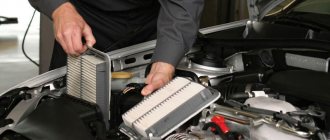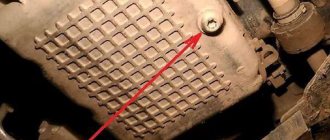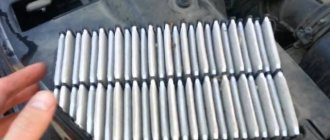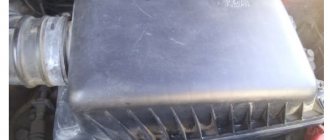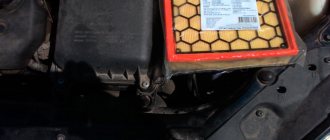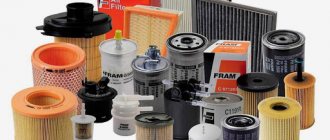Print this article Font size 16
Finding oil in the air filter of a carburetor VAZ 2109 does not bode well. This is a clear sign of serious problems that should be addressed immediately.
VF on the carburetor
Filter Features
To determine the reasons for the presence of oil in the filter, the first step is to find out about the features of its operation and functions.
Some people mistakenly believe that VF is an ordinary consumable that does not require special attention. Because of this, checking the condition of the air filter is extremely rare. Sometimes it comes to the point that when dismantling the element, drivers find something like an old dirty rag instead of a filter.
For efficient combustion of the air-fuel mixture in a carburetor engine, it is necessary that the amount of air exceeds the amount of fuel by approximately 15-20 times.
On average, a car uses approximately 15 cubic meters of air per 100 kilometers. It contains a lot of dust, sand, plant components and other debris. If it weren't for the filter, all this would end up in the engine itself. As a result, dirt will begin to have an abrasive effect on the rubbing elements, which will lead to wear.
To prevent such a nuisance, which threatens serious engine damage, an air filter (AF) is installed on the VAZ 2109. In addition to the main function of cleaning, the filter also serves as a muffler and fuel cooler.
Brand new filter element
Why does oil get in?
To understand why oil particles appear in the air filter, consider the following carburetor operation algorithm:
- When fuel burns, crankcase gases are formed;
- In the normal state of the engine, they are completely removed from the cylinders;
- If the engine is worn out, coked, or has other problems, some of the crankcase gases remain inside;
- This provokes the creation of high blood pressure;
- Due to increased pressure, the condition of the seals deteriorates and they cannot perform their functions properly;
- If the oil seals are damaged, oil consumption increases and it begins to flow into the VF.
Oil in VF
There are several main reasons why the VF becomes contaminated with oil.
| Cause | Nuances |
| The piston rings of the power unit are worn out | This leads to a disruption in the proper functioning of the collection of excess lubricant that enters the crankcase from the cylinder. Pressure increases, oil is squeezed out by the oil deflector and vent valve. A clogged oil deflector drain does not allow the lubricant to return back to the crankcase, so it escapes along with the gases |
| The crankcase gas outlet paths are clogged | If the paths are clogged, gases from the crankcase cannot fully escape the throttle limits. As a result, we get lubricant and gases in the air filter |
| Air cleaning material is clogged | The engine does not receive enough air, so it begins to suck it in from all available sources. Not rarely - from the crankcase. As a result, it turns out that the filter is flooded with oil. |
Piston rings
How does an air filter work?
The dry type air filter of the VAZ 2109 car has replaceable filter elements.
On the VAZ 2109, the air filter device includes:
- Frame. It is attached to the carburetor with self-locking nuts using four studs and sealed with a rubber gasket.
- Lid.
The lid and body are made by stamping from sheet steel, after which they are painted with a black primer. The cover is attached to the body with four spring latches, and in the center there is a bracket pin onto which a nut is screwed.
The bracket is welded to the filter housing. The tightness of the unit is ensured by a sealing gasket made of polyurethane foam, which is glued to the filter cover.
To prevent increased noise during inlet, the product cover is installed in a certain way.
When installing it on the inlet pipe, the arrows of the two parts should be directed towards each other:
- For VAZ 2109, the corrugation for the air filter is made of special filter cardboard.
- The inner and outer shells are made of tin.
The filter element and shells are filled into elastic covers made of self-hardening sealant.
Due to this, when installing the air filter cover, the filter element with the cover and housing is reliably sealed:
- Cold air vent.
- Warm air collector.
- Corrugated hose.
In order to increase the collection of dust by the filter element, a pre-cleaner made of synthetic wool is placed on the outer perforated shell. Air is sucked in through the intake pipe located on the air filter housing, on which the crankcase exhaust ventilation manifold is located. The hose sucks crankcase gases through the manifold into the air filter. There, in the space behind the filter element, gases are mixed with clean air and sent to the carburetor.
- A plastic thermostat with a cold air intake made of polyurethane foam is attached to the inlet pipe located on the body, which reduces the air intake noise. A corrugated hose connects the lower pipe of the thermostat and the warm air collector, which takes this air in the exhaust manifold area. When the engine is warm, the thermostat maintains the temperature of the air entering the air filter at 25 - 35 degrees Celsius
The thermostat consists of:
- collapsible plastic case;
- hinged damper;
- traction;
- thermoelectric element.
The lower arm of the damper is pivotally connected to the rod, and the second end of the rod is pressed by a spring against the pusher of the thermal power element, to which the rod is rigidly connected, which is screwed into the plug on the thermostat body. When heated, the heat-sensitive filler expands, which activates the pusher, which closes the damper through the rod.
The suction air washes the thermal power element, which, when the air temperature rises above +35 degrees, closes the pipe through which warm air flows with a damper, and if the air temperature is less than -25 degrees, the damper closes the pipe for the movement of cold air.
In this case, the air will be sucked in warm from the exhaust manifold. The intermediate position of the damper and the optimal temperature of the air entering the engine will be at a temperature of +25 to -35 degrees Celsius.
Air purification system for VAZ 2109
Positions in the photo:
- 1 – cold air intake VAZ 2109;
- 3 – thermostat;
- 4 – arrows for mounting the cover;
- 5 – cover for the air filter;
- 6 – thermostat housing;
- 7 – damper;
- 8 – traction;
- 9 – pusher;
- 10 – rod;
- 11 – thermal power element;
- 12 – pre-cleaner;
- 13 – filter element;
- 14 – perforated shell;
- 15 – exhaust ventilation manifold;
- 16 – corrugated hose;
- 21 – warm air collector.
Repair work
If you discover the presence of oil in the air filter of your VAZ 2109, you should definitely take immediate action.
Ignoring the presence of oil in the VF can lead to serious damage, including the need for major engine repairs. I don’t even want to imagine how much it will cost.
- Check the compression of your engine. If there are problems with it, the piston rings or the piston system are worn out, this can be determined by blue or dark smoke. Plus, the level of lubricant, that is, oil, will constantly drop.
- If the compression test shows that everything is fine, then you can breathe a sigh of relief. This suggests that the problem is not that complex.
- Most likely, the filter element is clogged or the hoses for removing crankcase gases from the crankcase are clogged. You will have to change the filter, wash or replace the output hoses.
The most important recommendation is periodic maintenance of all engine components and auxiliary mechanisms. It is better to prevent a disease than to eliminate its consequences later.
Replacement frequency
Replacing the air filter is necessary every 15-20 thousand km. It is recommended to periodically blow out the filter element with compressed air. However, sometimes it may be necessary to unscheduledly replace the filter.
Symptoms of the need to install a new consumable are:
- noticeable loss of power from the power unit;
- the car had to cover a long stretch of dusty dirt road;
- fuel consumption has increased;
- the previous replacement period is unknown, for example, when purchasing a used car;
- There is a lot of oil getting into the air filter;
- The filter element has noticeable mechanical damage, which does not allow quality air purification.
Compression check
After checking the compression, you can breathe a sigh of relief or worry, since the cost of the repair depends on the result.
Impaired compression often causes the presence of oil in the VF, and also causes a number of other problems.
Compression check
To work you will need:
- Compressometer;
- A rag in oil, which you will use to determine the compression stroke;
- Adapter for spark plug holes. It is used when checking the combustion chamber for leaks;
- Compressor.
Now let's start checking.
- Warm up the engine to operating temperature, then turn off the fuel supply.
- In the case of a carburetor, you need to remove the hose, clamp or squeeze it with something, or lower it into a container.
- If you have an injector, remove the fuel pump fuse, start the engine and let it run. As soon as the fuel in the fuel rail runs out, it will stall on its own.
- Disconnect the ignition system by removing the center wire from the distributor (on the carburetor). The crankshaft position sensor at the injector must be disconnected.
- Remove all debris from the spark plug wells so that it does not end up inside the cylinders. Unscrew the spark plugs.
- Insert the compression gauge fitting while an assistant starts the engine. The starter should rotate the engine until the pressure gauge needle stops in one position.
- By analogy, measurements are carried out on each cylinder, the results are recorded on paper.
- To calculate ideal compression, use the formula - 1.2 * Compression ratio.
See your owner's manual for the compression ratio of your engine. Please also note that measurements may have some error.
What you need to know about verification
- If the indicator is 12 atmospheres, this indicates that your engine is almost in perfect condition.
- When checking the compression on a cold engine, the compression readings will be significantly lower. Perform the test only on the engine at operating temperature.
- If the battery is partially discharged, the test data will also not be accurate.
- The increase in compression occurs due to the combustion of oil in the cylinders.
What the results say
We take the paper where you wrote down the data of the check, carried out according to all the rules, and study what is wrong with the motor.
- Indicators in the range of 0-4 atm indicate a high probability of burnout of the piston, head gasket or valve.
- Compression of 4-6 atmospheres indicates that the piston rings or the partition between them have broken.
- If you get about 8-10 atm in each cylinder, the cylinder-piston group is worn out. Major repairs will soon have to be carried out.
- 12-12.5 atm - these are the indicators that occur in a new, run-in power unit.
- If the car has serious mileage, and the check data shows numbers equal to or exceeding the norm, oil has probably entered the cylinders due to wear of the cylinder-piston group or valve liners.
Obviously, the presence of oil in the filter does not bode well. But the problem can still be prevented if measures are taken in time.
Why do you need an adapter, how to make it yourself and install it
A solution was found: this is a cabin filter adapter from a VAZ 2110 for a VAZ 2109. This adapter can either be ordered online from the manufacturer, or you can design it yourself. For those who want to save money, here you can get drawings and patterns for making an adapter with your own hands.
Installing the adapter is simple: it is installed instead of the standard stove motor casing using standard mounting holes. It consists of two parts for ease of installation in limited space in the air supply box. A VAZ 2110 cabin filter is installed in the installed adapter. The area of the hole through which air is drawn into the cabin is larger for such an adapter than for the standard casing, and therefore the weakening of the air flow going into the cabin, if noticeable, will be very small .
Before installing a purchased or home-made cabin filter adapter, it is advisable to clean the entire heater of debris: if you did not have any protection on the standard casing, there may be quite a lot of it there. You can remove accumulated debris from the bottom of the stove body using a home vacuum cleaner by removing the stove motor and inserting the vacuum cleaner pipe into the opened air intake hole. Then you should install a filter or replace the existing one.
If you have a type “B” heater (see figure), in order to reach the bottom of the stove, you need to move the central damper to the “hot air” position. It would also be a good idea to clean the heater radiator - if the radiator is clogged and there is a cabin filter, the windows in the car may fog up.
